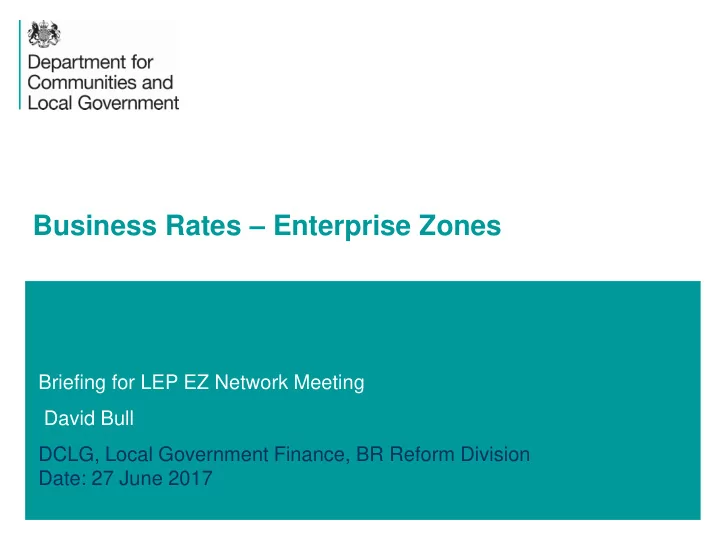

Business Rates – Enterprise Zones Briefing for LEP EZ Network Meeting David Bull DCLG, Local Government Finance, BR Reform Division Date: 27 June 2017
The Business Rates Tax • Business Rates (the National Non-Domestic Rates) system for England - Scotland, Wales and Northern Ireland have their own business rates systems - introduced on 1 April 1990. The system is tightly defined in primary and secondary legislation. • It is a tax paid by the occupier (or owner if empty) of non-domestic hereditaments/ properties (including such things as telephone masts, advertising hoardings, cash machines etc) in England. • The bill is a product of the rateable value of the property and the “multiplier” set by central government. 326 local billing authorities administer the business rates system. • Businesses can appeal against their rateable value, firstly to the Valuation Office Agency and then to the Valuation Tribunal for England.
Rateable Values • The Valuation Office Agency (VOA) is responsible for valuing business and domestic properties. • The rateable value represents the open market, annual rental value of a non-domestic property. All ratepayers have a right of appeal against their rateable value. • All business and non-domestic properties are valued on the same date every five years. • Although the last revaluation was in 2017, the next one is due in 2022. Revaluations do not raise more tax and the Government is pressing ahead with work to look at how we can deliver more frequent revaluations.
Example Rates Bill Period RV 10.000 - 01 April 2017 - 31 Mar 2018 Rateable Value x Multiplier = Bill 10.000 x 46.6p = £4,660 If eligible for Charity Relief 80% x 4660 = £932
Reliefs Mandatory relief • Charity relief – 80% relief • Rural rate relief – 50% relief • Empty Property Relief – 100% relief for 3 (non industrial) or 6 months (industrial) • Small Business Rate Relief – up to 100% relief Discretionary relief • Authorities also have a general power to grant discounts (s47 of the Local Government Finance Act 1988) as they see fit. Central Government meets half of the costs of any local discount granted.
Existing 50% Rates Retention • Since 2013-14, local government retains 50% of the local business rates they collect – the “local share” • The remaining 50% is returned to central government – the “central share” • The “local share” is • apportioned between the different tiers of local government – eg London Borough’s retain 30% of their business rates; GLA gets 20% of each Borough’s business rates • some of the local share is “redistributed” between authorities – resource-rich authorities give up some of their share – they pay a “tariff”, which is used to provide a “top - up” to resource -poor authorities. 6
Enterprise Zones under existing 50% rates retention • In contrast to the 50% rates retention scheme, in Enterprise Zones: • The LEP through the billing authority keeps 100% of growth above a baseline (representing the business rates income in the designated area before the EZ started) in the Enterprise Zone area • 100% growth is kept in each of 25 years – in other words, the income in the EZ is not caught by the re-set • Provides a certain income stream over 25 years against which authorities can plan/invest • The value of EZs has been growing: 2013-14 £2.7 million 2014-15 £15.3 million 2015-16 (forecast) £21.6 million 7
Enterprise Zone Discount • The Government has committed to fund a 100 per cent business rates discount for a five year period up to state aid de minimis levels for businesses that move into Enterprise Zones before April 2018. • Authorities will provide the discount using the local discount powers contained in section 47 of the Local Government Finance Act. 8
BR Discount and BR Retention – mapping Blue Area Map Only – BR Relief: Keep Growth above baseline only Blue and Red Area Map Only – BR Retention : Keep Growth above baseline AND Ability to give Case A BR Discount – compensated in full Red Area Map Only – Ability to give Case B BR Discount only- Compensated to 50%
Data • All the data needed to make the necessary calculations is captured through authority end of year returns called NNDR3s. • The NNDR3 is the form which authorities use to provide all the information that they need to submit to the Department on business rates collection under the business rates retention process • The NNDR3 is subject to the usual audit processes. 10
Previous position on implications of 100% Rates Retention for EZs • LG Finance Bill does not form part of the new Parliamentary Session • Government is committed to delivering its manifesto commitments to help LAs to control more of the monies they raise For reference – previous position • No impact on existing EZs: • Secondary legislation setting-up existing EZs is set in stone for 25 years • Whilst authorities will keep 100% of business rates growth under both EZ and 100% rates retention: • EZs will continue to be outside any reset and hence historic growth will not be redistributed. 11
Recommend
More recommend